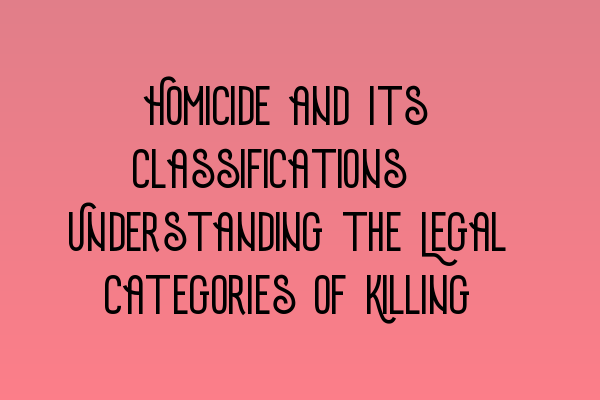Homicide and Its Classifications: Understanding the Legal Categories of Killing
Homicide is a term used in the legal field to describe the act of one person causing the death of another. It is a serious offense and comes with severe legal consequences. In this article, we will explore the different classifications of homicide and provide a clear understanding of the legal categories of killing.
1. Murder
Murder is the most serious form of homicide and involves the intentional killing of another person. It requires the element of malice aforethought, which means that the perpetrator had the intent to cause death or serious bodily harm. Murder is further divided into two categories:
a. First-degree Murder
First-degree murder is a premeditated and deliberate killing. It involves a planned action with clear intent. This category of murder often carries the highest penalties and punishments, such as life imprisonment or even the death penalty in some jurisdictions.
b. Second-degree Murder
Second-degree murder is an intentional killing that lacks premeditation or deliberation. It occurs in the heat of the moment, without planning or forethought. Although the intent to kill is present, it may be less severe than in first-degree murder cases. Penalties for second-degree murder are still significant but may be less severe compared to first-degree murder.
2. Manslaughter
Manslaughter involves the act of killing another person without malice aforethought. Unlike murder, manslaughter is not premeditated or intentional. It generally occurs in situations where there was no intent to cause death, but the actions of the perpetrator resulted in the death of another person. Manslaughter is divided into two categories:
a. Voluntary Manslaughter
Voluntary manslaughter occurs in cases where the killing was intentional but resulted from a sudden and intense passion or provocation. The perpetrator may have been provoked or emotionally overwhelmed, leading to an impulsive act of violence. Penalties for voluntary manslaughter are less severe compared to murder.
b. Involuntary Manslaughter
Involuntary manslaughter refers to cases where the killing was unintentional but occurred due to the negligent or reckless actions of the perpetrator. This can include situations where the person did not intend to cause harm but behaved in a manner that created a substantial risk of severe injury or death. Penalties for involuntary manslaughter are generally less severe than for murder or voluntary manslaughter.
Understanding the various classifications of homicide is essential for legal professionals, as it enables them to navigate the complexities of criminal law cases involving killings. The appropriate charge and potential penalties depend on the circumstances and intent behind the act.
To prepare yourself for the SQE Criminal Law & Practice exam, it is crucial to review and understand these classifications thoroughly. For practice exam questions, check out our SQE 1 Practice Exam Questions resource. Additionally, our SQE 1 Practice Mocks FLK1 FLK2 can help you familiarize yourself with the format and structure of the exam.
For comprehensive preparation for the SQE 2 Criminal Law & Practice exam, we offer SQE 2 Preparation Courses designed to equip you with the knowledge and skills required to excel in this area of law. If you’re just starting your SQE journey and need guidance for SQE 1, our SQE 1 Preparation Courses can help you lay a solid foundation.
Stay updated with the latest SRA SQE exam dates to ensure you don’t miss any crucial deadlines. Visit our article on SRA SQE Exam Dates for more information on upcoming exams.
